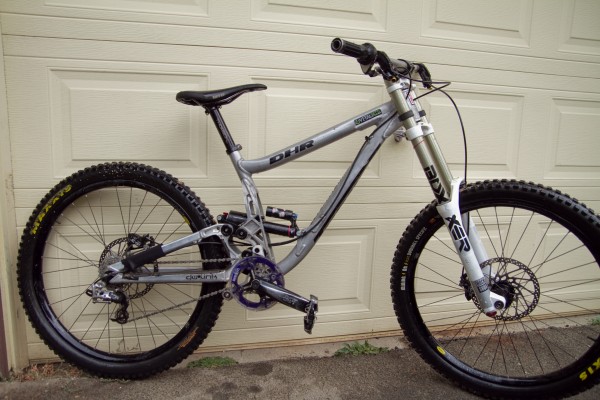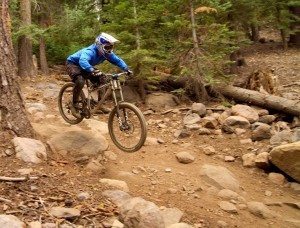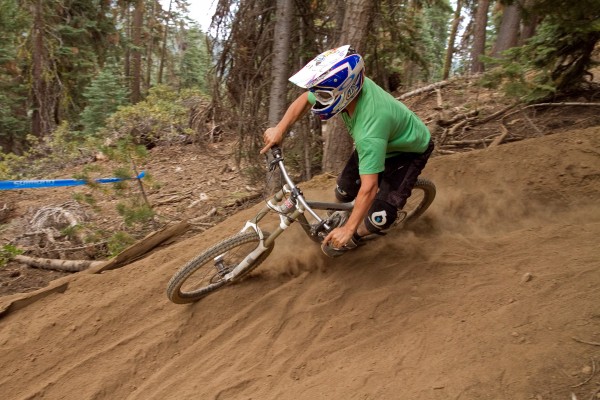Frame: 2011 Turner DHR, Medium
Intended Use: Noble acts of bravery and speed in gnarly places, as long as they’re downhill.
Rider: 5’9”, 160 lbs., downhiller, dirtjumper, and trailrider of many years. Likes speed, dangerous lines, and cute puppies. Still has funny looking mustache.
Geometry Chart: Turner DHR
Locations Tested: Northstar at Tahoe, Sol Vista Bike Park, Mammoth Mountain, Whistler BC, a gaggle of shuttle locations between Tahoe and BC.
Other similar frames ridden recently: Santa Cruz V10c, Transition TR450, the last 3 Specialized Demo 8 frames, every previous Turner DHR
Current Build
Fork: 2011 Rockshox Boxxer World Cup (air)
Rear Shock: Rockshox Vivid Air
Wheels: Mavic 729s on DT Swiss FR 440 rear, Ringle Jumping Flea front
Cranks: OCT Truvativ Holzfellers
Drivetrain: Sram X9 derailleur, XO Gripshifter (yes, really), Saint Cassette, some SRAM chain
Brakes: Shimano Saint
Tires: Maxxis 2.7 Minion DHF front, 2.5 Minion DHF rear
Weight: Somewhere around 38 lbs.

After many delays, headaches, canceled orders, and front triangle revamps, this frame finally exists. If you live in a popular DH spot, I’d actually be surprised if you haven’t seen at least one in person yet. Before the carbon frenzy, this was arguably one of the most highly anticipated frames threatening to see production, and with good reason.
About three years ago, the already popular Turner bikes all saw a revamp in suspension design from the man behind the now legendary Iron Horse Sundays, David Weagle. Turner DH bikes have always had a healthy following, but with the promise of Gucci suspension, Sunday owners (no small part of the population), longtime Turner loyalists, and all kinds of riders who were unaffiliated with either camp wanted to see how this thing turned out.
I’m not going to go too deeply into the DW-Link suspension theory, but the basics are as follows: Drivetrain forces are used to produce what’s commonly called anti-squat, a resistance to suspension compression under drive loads. This is meant to counteract the rearward mass and / or momentum shifts under acceleration. The common theme I’ve noticed across all the DW-Link bikes I’ve ridden is that they do strike a nice balance between maintaining bike attitude and still allowing the suspension to react to terrain features while pedaling, even stand-up mashing.
Although it may not be the centerpiece of the design, there’s also some thought given to keeping the rear end somewhat active under braking, preventing the bike from getting stuck in a squat, something akin to packing up. Now pretty much every single suspension bike manufacturer makes these claims about whatever their general design is called. Some succeed to varying degrees, some don’t, and some even do the exact opposite of what the manufacturer claims.
In my experience, the DW-Link bikes work as claimed for the most part. Some consider them a little stiff when pedaling because some suppleness is lost under chain loads. I actually like that. If I’m pedaling over something really rough, it’s usually at low speeds, so forward drive is more important than following terrain.
Other bikes I’ve owned of the Santa Cruz / Intense VPP variety also work very well in the same realms that DW-Link bikes have gotten a reputation for. But a noticeable difference (especially with some of the Santa Cruz bikes) is that there’s a greater response to terrain under pedaling. I’m not saying which is better, both designs work well, and especially on trail bikes. Just be aware that the DW-Link suspension is one variation on a theme, and it’s a theme that, when tuned to be somewhat progressive, I happen to like…something I would say about the VPP bikes, too.
I was fortunate enough to get one of these frames mid-summer, 2010. I’ve ridden it in essentially two incarnations, one coil sprung on both ends, now air on both. The frames ship with a Fox RC4 boinger, and through the beginning of this summer, that’s what I rode along with a 2010 Boxxer Team. I’m now on Rockshox air bouncies front and rear, Boxxer WC and a Vivid Air. Having a somewhat early released frame, I’ve been able to pound on it pretty well in a variety of different regions, which included setting it up appropriately for the terrain.



I LIVE IN TENERIFE, A HILLY PLACE.I LIKE TO PEDAL UP TO COME DOWN. I WANT TO BUY A TURNER DHR FRAME, I WONDER IF I COULD INSTALL A TWO RINGS CRANKSET, TO MAKE THE TURNER DHR MORE SUITABLE TO PEDAL UP ? I WOULD LIKE SOME ADVICES, THANKS
I’m not sure the DHR is really what you’d want for any kind of pedaling uphill Hugo. I’ve done it before with mine but just up some fairly mellow dirt roads. I mean it is a downhill bike. Maybe something like a Transition TR250 or a specialized enduro evo would be better.
Hi there
Can you post your settings on your boxxer world cup? How much sag and other thing.
I sold the Boxxer last year so I can’t check precise setting unfortunately. At 165lbs riding weight, I think I was running around 80psi for pressure with the bottom out volume reducer pretty much maxxed out. Those forks felt so spikey to me that I ran very minimal compression damping. I think just a few clicks in a low speed compression damping and literally no high speed damping.
That’s just on memory, sorry I couldn’t be more specific.